Big Bore Productions
New member
Africa The Way It Used To Be
by Mark Buchanan

Mountains in Ethiopia
As usual my first night on Safari started in the hotel bar. Mike (the cameraman) and I had a few beers, then a few scotches savoring the final hours of modern conveniences. Early the next morning we awoke to pouring rain and our room swarming with mosquitoes. It was nice to be back in Addis Ababa. The people are friendly and the scenery is beautiful. I was hunting with Nassos who owns Ethiopian Rift Valley Safaris, I hunted with him previously for my Mountain Nyala.
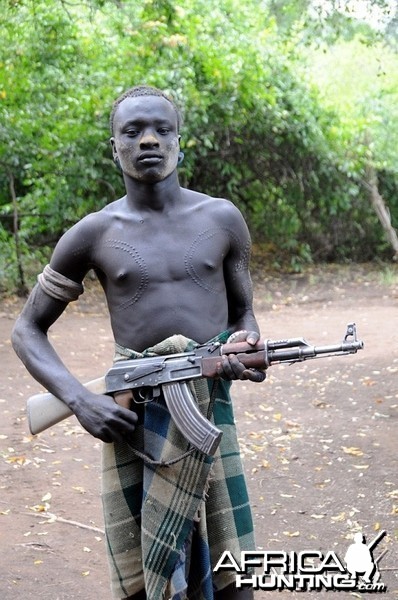
Ethiopian with AK 47
We chartered a flight from Addis to Sala, which is about 100 miles north of the Kenyan border. When we landed at the airstrip we were greeted by several natives (Mursi's) covered in paint and mud and most armed with AK47's. This was the real deal, the last time I saw an AK47 was when the poachers in Zim opened up on us, and so I was a little on edge. There are 88 different tribes and languages in Ethiopia and the Podi's and Mursi's used to be at war but were now at peace, but every year various tribes were fighting and killing each other. Sala was one of the most wild places I have ever hunted, the natives were about as savage as you could get. Most were not friendly and there was no point at waiving when you saw them. Even most of our camp staff were employed from the local tribes and also very unfriendly and emotionless. It was a very different feeling hanging out in camp. The Mursi have cattle and frequently watered them near our camp so there were always people walking through or near our camp, 75% time carrying AK's. We had one girl in camp and she never smiled at us, just glared.

Double Rifle on Nile Buffalo
In Sala we hunted Nile buffalo, Chanlor Mountain reed buck and Neumann's hartebeest. The camp in Sala was located on the Sala River surrounded by mountains. The terrain was very different from any other parts of Africa I had been. The camp was very primitive and very wild, the nearest village was a three hour drive. Unfortunately a previous storm had washed out the bridge and kept us from hunting half of the concession. The side we hunted only had two roads, one along the river and another which ran through the middle of the concession. When I say roads, they more closely resemble tracks cut previously across the savannah. The roads are very bumpy, and off road was worse. We rarely traveled on the roads and traversing the countryside was a bumpy ride at best. We punctured tires three times in two days.
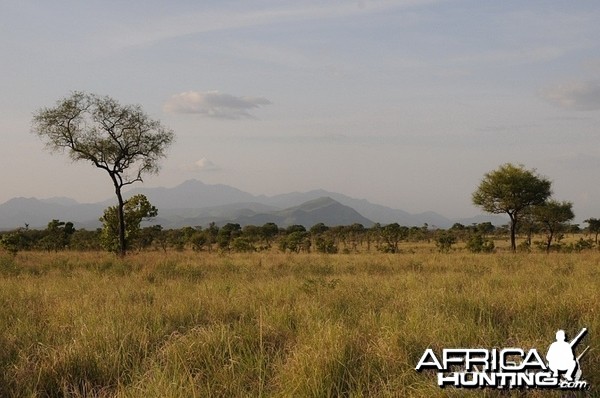
Ethiopian Landscape
July is hot in Sala, very hot and very humid. Some mornings it was not uncommon to be completly drenched in sweat by 7:00am when in pursuit of buffalo. By 10:00am the game quit moving and we returned to camp. It was so hot there was nothing to do but sleep, and sleep was not easy. The Tsetse were thick around the camp forcing us into our tents, which allowed very little breeze to pass through.
After hunting in Tanzania and Zambia, I felt I finally found the best repellent for Tsetse flies, Avon "skin so soft". The tsetse were not as bad as I have encountered in the past, but the Sala was loaded with flies. Bigger than mopane flies but smaller than a common house fly. In some areas they were thick and extremely annoying and they seemed to lick the repellent like it was there last supper. Just when you have it all figured out, there is a new critter to add to the misery factor.
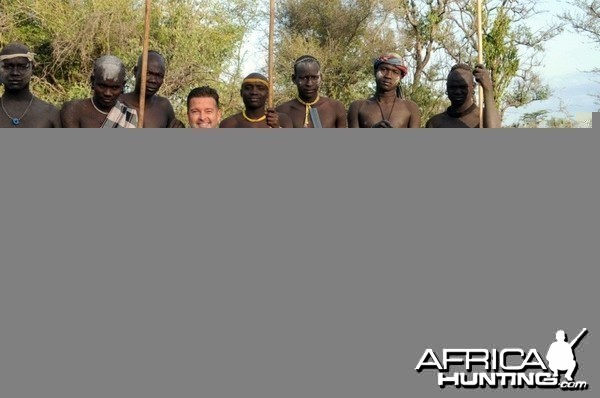
Nile Buffalo
I shot a big Neumann's Hartebeest, this is the only place in the world to shoot one. The buffalo are Nile Buffalo, and there are only a few places in Ethiopia to hunt them. They used to hunt them in Uganda, but Uganda has been closed for many years. The Nile buffalo are about 75% in body size of a Cape and slightly larger than the western Savannah buffalo. I shot him at 70 yards with my Marcel Thy's .375 flanged with open sights. John LaSala of Safari Ammo loaded up my ammo for the 375 and 300H&H with Barnes triple shock bullets. First shot was a heart shot, the second in the shoulder, he ran 50 yards and collapsed.
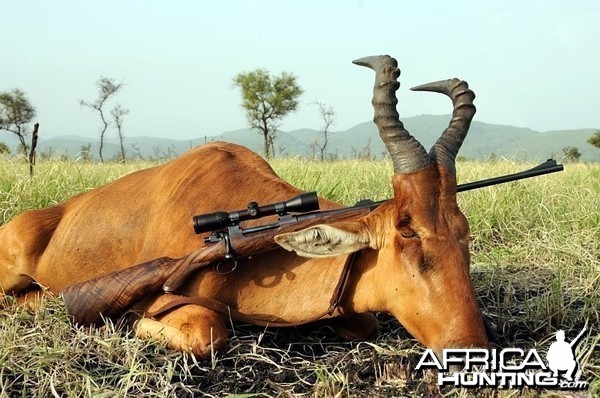
Neumann's Hartebeest
We also hunted daily for the Chanler Mountain Reedbuck which according to Nassos is the most difficult animal to hunt in Ethiopia and I agree. Basically you climb into the mountains and glass. The mountains are not that rugged, but they are covered with boulders and every step is a potential ankle breaker, not to mention the heat. Luckily I grabbed a pair of Russell Mountain PH's at the last minute. Hunting the reedbuck is tough because of their size and color and in the tall grass they are real difficult to find.
Sometimes they stand in the same position for hours and move very little. In seven days we spotted 14, 13 of which were females. I was very excited to be the only one to spot one on one of the days. On the seventh day we climbed to the very top of the mountain, it was one of the hottest days. On our way back down, one of the trackers spotted a male standing in the grass at 275 yards down hill. It took me several tense minutes to find it in my binoculars, Mike could not even find it, and I had to zero in the video camera.
I was shooting my new 300H&H built by Joe Smithson on a GMA action. I tried to control my breathing the best I could, and shooting off my Long Grass shooting sticks I took aim, I could barely make out the black horns and the outline of the body in the grass. I was so torn between waiting several minutes for my breathing to slow down, but risking the fact the ram could take a few steps and disappear. There was so much riding on this shot, we worked so hard to get to this point and I really did not want to go back up the mountain one more day. It was impossible to keep the cross hairs on target; I squeezed the trigger, and pulled off my best shot ever in Africa. Everyone was very excited. In 27 years Nassos has only shot eight total, and did not think there were more than ten in the record book from Ethiopia. We got back to camp exhausted it was 126 degrees in the sun.
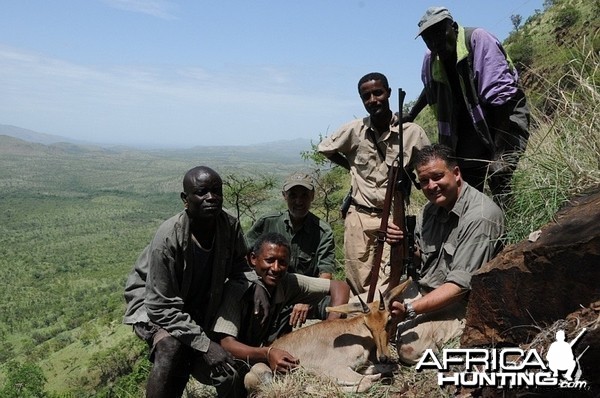
Chanler Mountain Reedbuck
On the 8th day we moved to the 2nd camp in the Omo valley which is just 30 miles north of the Kenyan and Sudan borders. The Scenery is spectacular and similar to Masailand. On the first evening we headed south out of the camp toward the plains and spotted two Tiang. (Very similar to Topi but prettier) One of which appeared to be very nice. Tiang can only be hunted in the Omo valley and have become increasingly more difficult to hunt. After several failed stalks the larger of the two made a mistake and stopped quartering away. Again the Smithson drilled him perfectly.
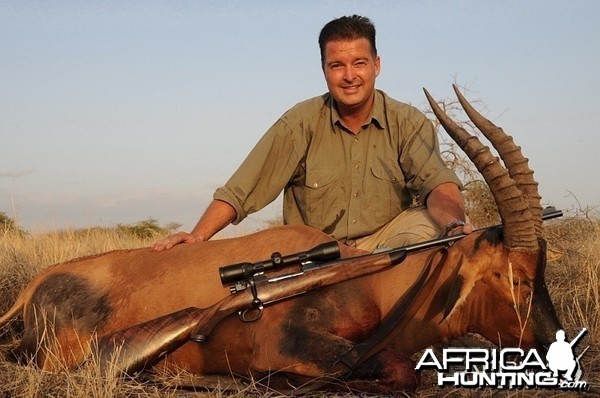
Tiang
I did not I know the lesser Kudu and Abyssinian Bush buck are hunted in the mountains. I also quickly learned the Abyssinian bushbuck is the second hardest trophy in Ethiopia and my top priority. So there we were again morning and night hiking into the mountains, however the terrain was much easier and no rocks or flies. One morning we spotted about a 30" lesser kudu and I passed on it to Nassos surprise. A few mornings later another appeared about 180 yards away and was around 31" which is very good. We were in a good area for bushbuck and Nassos said we should wait, the trackers were going crazy. Then fifteen minutes later he appeared again at 160 yards and Nassos could not take it any longer and said shoot and I did, he ran about 25 yards.
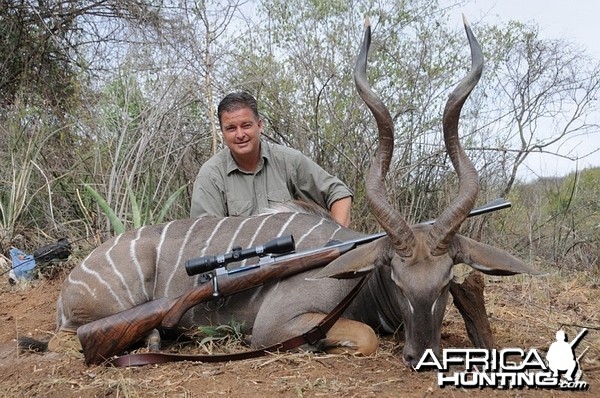
Lesser Kudu
You can glass the same hillside for three hours than magically the bushbuck appear for seconds or minutes then a few steps later disappear in to the thick bush. Over the next ten days we saw three females briefly. Hunting this bushbuck is nothing like the other subspecies, you had to glass and glass, very similar to hunting Mountain Nyala. Nassos was sending some of the tracker to different areas to glass so we could cover more ground. One morning Nassos spotted one of the trackers running down the ridgeline to us and knew they must have spotted one. We sprinted a good fifteen minutes uphill to get to the location. My lungs were about to burst, and as usual I have seven guys whispering to shoot in three language. Here we go again I thought, this time 265 yards slightly larger target, but severely winded. Again my better judgment said to wait, but finally seeing horns and knowing in one step he could be gone, I tried to hold the cross hairs steady, and fired. "You got him!" Nassos shouted, but for some reason I had a feeling he was not dead and stayed steady while everybody was shouting about where it was hit, where it ran, Nassos sent two guys around the ridge to find him while we stayed in position. Then just what I was dreading "he is up!" Nassos whispered, He move about 30 yards down will and was facing away. I shot again "high" he whispered, I shot again and hit him and he disappeared. The trackers arrived and the fun began. Blood and no bushbuck...
We moved down the mountain, the buck appeared to be going strong but was still dropping blood enabling us to track him to the thickest nastiest bush imaginable.
Unbelievably we jumped him twice, but with the tracker in the lead, then Nassos and me then Mike, there was no way to get a shot, we were too noisy. The tracker lost the track and blood several times; I really did not think we were going to find him. We lost the trail and sat and waited for 30 minutes for Balacho to find the trail again. Once he had us going in the right direction, 30 yards away found him dead. The Abyssinian bushbuck is without a doubt the most difficult of all the bushbuck to hunt.
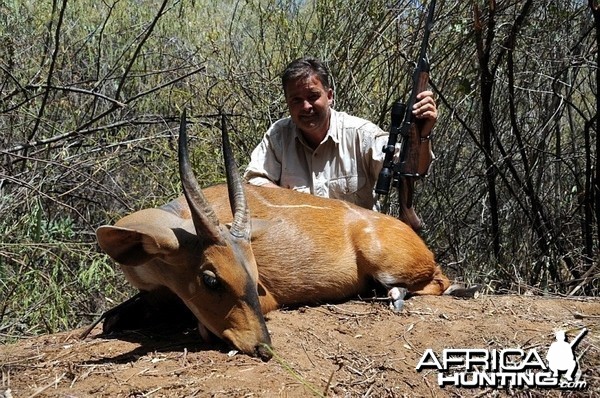
Abyssinian Bushbuck
I shot a Colubus monkey which are really pretty, a big Northern Grants Gazelle, and lastly a very nice Gunther's Dik Dik. Mike did a good job getting all the action on video.
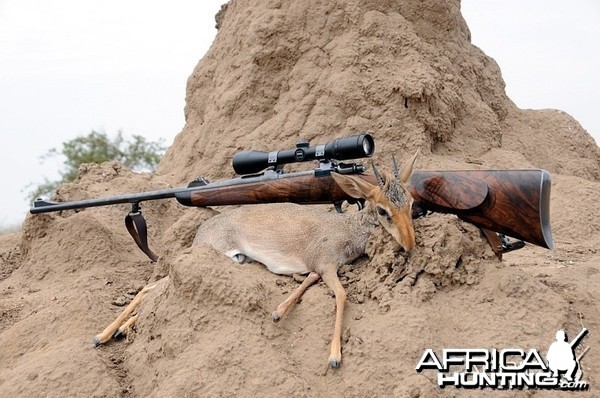
Gunther's Dik Dik

Grants Gazelle
This is not a safari for the first timer, hunting was difficult, conditions were difficult, but it was most definitely the most unique and prettiest parts of Africa. Parts of Omo Valley reminded me of Maisaland. What really made the trip unique was the wildness of the country and the people. Daily we saw the Karos, and Hammer tribes while hunting. The Karo's are mostly farmers and the Hammer's are mostly nomadic and move with their cattle, very similar to the Masia, but the meanest tribe around, most looked mean.
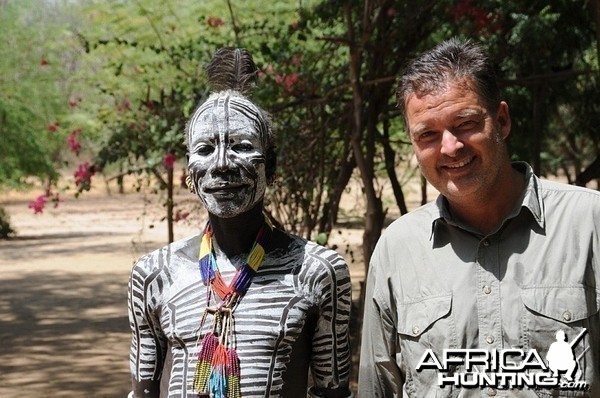
Ethiopian Tribe
We bought several belts and knives from them and it was crazy watching our guys negotiate for us. We were scared most of the time as our trackers tried to save us five bucks, I was happy to avoid a gunfight. They did not like us to take photos of them, and really did not like the video camera. Mike started videotaping their cattle and I thought a fight was going to break out. Every day was an adventure.
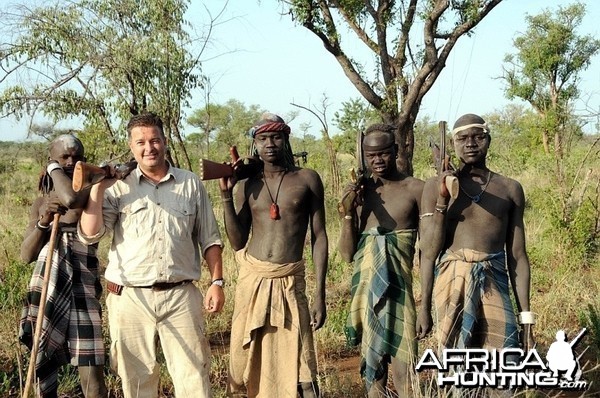
Ethiopian Tribe
It turns out our head tracker killed over 100 Bumi's (tribe across the river) a real bad ass. Our game scout used to be a poacher in Mago Park and killed everything with his AK 47, but did not like shooting elephants because when he shot them they did not die and just kept running!!!
We went to the three different villages. The Karo village was kind of calm, if you like 30 kids following you around and ladies glaring at you. In the midday heat not less than fifteen women would be found throughout the village grinding Sorghum by hand between two rocks. These villages were still living in the Stone Age, no pun intended. The villages were very crude, the Hammers were the most primitive because they were nomadic and did not build real permanent villages.
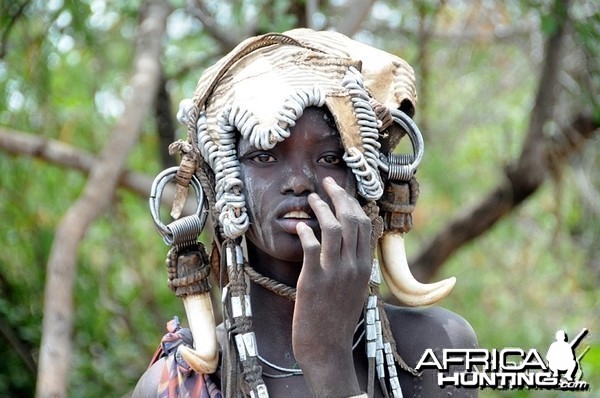
Young Ethiopian Girl
The grand finale was the Mursi village which was a bone jarring 10 hours round trip to the village, but worth every mile. Nasso's did not go, it was just Mike and I and our two scouts and driver. I did not take my rifles and when we passed through Mago Park we were surprised, but happy our game scout borrowed an AK from the border post.
The Mursi are the most decorative and known for the plates that are inserted into the women's lower lips. This started a long time ago as they believed that by making themselves ugly they would not be taken into slavery, and it worked! After they get married their lower front teeth are knocked out and an incision is made into the lip and gradually bigger plates are inserted gradually stretching the lip out. The entire process takes about a year and the bigger the plate the more the bride is worth.
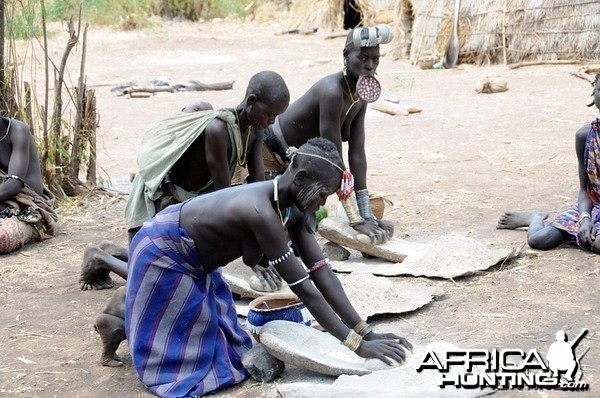
Ethiopian Women

Mursi People Ethiopia
Upon arrival at the village it did not take long for Chaos to break out. Unfortunately they are wise to the whole tourist deal and charge 1-2 Birr per photo. Video was even more difficult to figure out. Twelve Birr are equal to one US dollar. I handed my wad to Aduna our driver and told him he was in charge. I just started clicking away with my Nikon, and Mike with the video camera and pandemonium broke out with everyone trying to get compensated for having their spirit stolen. Our game scout took charge and did his best to keep them at bay. When we left our truck was surrounded, but I quickly began launching handfuls of Jolly Ranchers into the air and we escaped. Seeing the Mursi village was probably the highlight of the trip, it's very intriguing to see how many people still live so primitively. If you want to see unspoiled Africa, this is the place.
MB
by Mark Buchanan
Mountains in Ethiopia
As usual my first night on Safari started in the hotel bar. Mike (the cameraman) and I had a few beers, then a few scotches savoring the final hours of modern conveniences. Early the next morning we awoke to pouring rain and our room swarming with mosquitoes. It was nice to be back in Addis Ababa. The people are friendly and the scenery is beautiful. I was hunting with Nassos who owns Ethiopian Rift Valley Safaris, I hunted with him previously for my Mountain Nyala.
Ethiopian with AK 47
We chartered a flight from Addis to Sala, which is about 100 miles north of the Kenyan border. When we landed at the airstrip we were greeted by several natives (Mursi's) covered in paint and mud and most armed with AK47's. This was the real deal, the last time I saw an AK47 was when the poachers in Zim opened up on us, and so I was a little on edge. There are 88 different tribes and languages in Ethiopia and the Podi's and Mursi's used to be at war but were now at peace, but every year various tribes were fighting and killing each other. Sala was one of the most wild places I have ever hunted, the natives were about as savage as you could get. Most were not friendly and there was no point at waiving when you saw them. Even most of our camp staff were employed from the local tribes and also very unfriendly and emotionless. It was a very different feeling hanging out in camp. The Mursi have cattle and frequently watered them near our camp so there were always people walking through or near our camp, 75% time carrying AK's. We had one girl in camp and she never smiled at us, just glared.
Double Rifle on Nile Buffalo
In Sala we hunted Nile buffalo, Chanlor Mountain reed buck and Neumann's hartebeest. The camp in Sala was located on the Sala River surrounded by mountains. The terrain was very different from any other parts of Africa I had been. The camp was very primitive and very wild, the nearest village was a three hour drive. Unfortunately a previous storm had washed out the bridge and kept us from hunting half of the concession. The side we hunted only had two roads, one along the river and another which ran through the middle of the concession. When I say roads, they more closely resemble tracks cut previously across the savannah. The roads are very bumpy, and off road was worse. We rarely traveled on the roads and traversing the countryside was a bumpy ride at best. We punctured tires three times in two days.
Ethiopian Landscape
July is hot in Sala, very hot and very humid. Some mornings it was not uncommon to be completly drenched in sweat by 7:00am when in pursuit of buffalo. By 10:00am the game quit moving and we returned to camp. It was so hot there was nothing to do but sleep, and sleep was not easy. The Tsetse were thick around the camp forcing us into our tents, which allowed very little breeze to pass through.
After hunting in Tanzania and Zambia, I felt I finally found the best repellent for Tsetse flies, Avon "skin so soft". The tsetse were not as bad as I have encountered in the past, but the Sala was loaded with flies. Bigger than mopane flies but smaller than a common house fly. In some areas they were thick and extremely annoying and they seemed to lick the repellent like it was there last supper. Just when you have it all figured out, there is a new critter to add to the misery factor.
Nile Buffalo
I shot a big Neumann's Hartebeest, this is the only place in the world to shoot one. The buffalo are Nile Buffalo, and there are only a few places in Ethiopia to hunt them. They used to hunt them in Uganda, but Uganda has been closed for many years. The Nile buffalo are about 75% in body size of a Cape and slightly larger than the western Savannah buffalo. I shot him at 70 yards with my Marcel Thy's .375 flanged with open sights. John LaSala of Safari Ammo loaded up my ammo for the 375 and 300H&H with Barnes triple shock bullets. First shot was a heart shot, the second in the shoulder, he ran 50 yards and collapsed.
Neumann's Hartebeest
We also hunted daily for the Chanler Mountain Reedbuck which according to Nassos is the most difficult animal to hunt in Ethiopia and I agree. Basically you climb into the mountains and glass. The mountains are not that rugged, but they are covered with boulders and every step is a potential ankle breaker, not to mention the heat. Luckily I grabbed a pair of Russell Mountain PH's at the last minute. Hunting the reedbuck is tough because of their size and color and in the tall grass they are real difficult to find.
Sometimes they stand in the same position for hours and move very little. In seven days we spotted 14, 13 of which were females. I was very excited to be the only one to spot one on one of the days. On the seventh day we climbed to the very top of the mountain, it was one of the hottest days. On our way back down, one of the trackers spotted a male standing in the grass at 275 yards down hill. It took me several tense minutes to find it in my binoculars, Mike could not even find it, and I had to zero in the video camera.
I was shooting my new 300H&H built by Joe Smithson on a GMA action. I tried to control my breathing the best I could, and shooting off my Long Grass shooting sticks I took aim, I could barely make out the black horns and the outline of the body in the grass. I was so torn between waiting several minutes for my breathing to slow down, but risking the fact the ram could take a few steps and disappear. There was so much riding on this shot, we worked so hard to get to this point and I really did not want to go back up the mountain one more day. It was impossible to keep the cross hairs on target; I squeezed the trigger, and pulled off my best shot ever in Africa. Everyone was very excited. In 27 years Nassos has only shot eight total, and did not think there were more than ten in the record book from Ethiopia. We got back to camp exhausted it was 126 degrees in the sun.
Chanler Mountain Reedbuck
On the 8th day we moved to the 2nd camp in the Omo valley which is just 30 miles north of the Kenyan and Sudan borders. The Scenery is spectacular and similar to Masailand. On the first evening we headed south out of the camp toward the plains and spotted two Tiang. (Very similar to Topi but prettier) One of which appeared to be very nice. Tiang can only be hunted in the Omo valley and have become increasingly more difficult to hunt. After several failed stalks the larger of the two made a mistake and stopped quartering away. Again the Smithson drilled him perfectly.
Tiang
I did not I know the lesser Kudu and Abyssinian Bush buck are hunted in the mountains. I also quickly learned the Abyssinian bushbuck is the second hardest trophy in Ethiopia and my top priority. So there we were again morning and night hiking into the mountains, however the terrain was much easier and no rocks or flies. One morning we spotted about a 30" lesser kudu and I passed on it to Nassos surprise. A few mornings later another appeared about 180 yards away and was around 31" which is very good. We were in a good area for bushbuck and Nassos said we should wait, the trackers were going crazy. Then fifteen minutes later he appeared again at 160 yards and Nassos could not take it any longer and said shoot and I did, he ran about 25 yards.
Lesser Kudu
You can glass the same hillside for three hours than magically the bushbuck appear for seconds or minutes then a few steps later disappear in to the thick bush. Over the next ten days we saw three females briefly. Hunting this bushbuck is nothing like the other subspecies, you had to glass and glass, very similar to hunting Mountain Nyala. Nassos was sending some of the tracker to different areas to glass so we could cover more ground. One morning Nassos spotted one of the trackers running down the ridgeline to us and knew they must have spotted one. We sprinted a good fifteen minutes uphill to get to the location. My lungs were about to burst, and as usual I have seven guys whispering to shoot in three language. Here we go again I thought, this time 265 yards slightly larger target, but severely winded. Again my better judgment said to wait, but finally seeing horns and knowing in one step he could be gone, I tried to hold the cross hairs steady, and fired. "You got him!" Nassos shouted, but for some reason I had a feeling he was not dead and stayed steady while everybody was shouting about where it was hit, where it ran, Nassos sent two guys around the ridge to find him while we stayed in position. Then just what I was dreading "he is up!" Nassos whispered, He move about 30 yards down will and was facing away. I shot again "high" he whispered, I shot again and hit him and he disappeared. The trackers arrived and the fun began. Blood and no bushbuck...
We moved down the mountain, the buck appeared to be going strong but was still dropping blood enabling us to track him to the thickest nastiest bush imaginable.
Unbelievably we jumped him twice, but with the tracker in the lead, then Nassos and me then Mike, there was no way to get a shot, we were too noisy. The tracker lost the track and blood several times; I really did not think we were going to find him. We lost the trail and sat and waited for 30 minutes for Balacho to find the trail again. Once he had us going in the right direction, 30 yards away found him dead. The Abyssinian bushbuck is without a doubt the most difficult of all the bushbuck to hunt.
Abyssinian Bushbuck
I shot a Colubus monkey which are really pretty, a big Northern Grants Gazelle, and lastly a very nice Gunther's Dik Dik. Mike did a good job getting all the action on video.
Gunther's Dik Dik
Grants Gazelle
This is not a safari for the first timer, hunting was difficult, conditions were difficult, but it was most definitely the most unique and prettiest parts of Africa. Parts of Omo Valley reminded me of Maisaland. What really made the trip unique was the wildness of the country and the people. Daily we saw the Karos, and Hammer tribes while hunting. The Karo's are mostly farmers and the Hammer's are mostly nomadic and move with their cattle, very similar to the Masia, but the meanest tribe around, most looked mean.
Ethiopian Tribe
We bought several belts and knives from them and it was crazy watching our guys negotiate for us. We were scared most of the time as our trackers tried to save us five bucks, I was happy to avoid a gunfight. They did not like us to take photos of them, and really did not like the video camera. Mike started videotaping their cattle and I thought a fight was going to break out. Every day was an adventure.
Ethiopian Tribe
It turns out our head tracker killed over 100 Bumi's (tribe across the river) a real bad ass. Our game scout used to be a poacher in Mago Park and killed everything with his AK 47, but did not like shooting elephants because when he shot them they did not die and just kept running!!!
We went to the three different villages. The Karo village was kind of calm, if you like 30 kids following you around and ladies glaring at you. In the midday heat not less than fifteen women would be found throughout the village grinding Sorghum by hand between two rocks. These villages were still living in the Stone Age, no pun intended. The villages were very crude, the Hammers were the most primitive because they were nomadic and did not build real permanent villages.
Young Ethiopian Girl
The grand finale was the Mursi village which was a bone jarring 10 hours round trip to the village, but worth every mile. Nasso's did not go, it was just Mike and I and our two scouts and driver. I did not take my rifles and when we passed through Mago Park we were surprised, but happy our game scout borrowed an AK from the border post.
The Mursi are the most decorative and known for the plates that are inserted into the women's lower lips. This started a long time ago as they believed that by making themselves ugly they would not be taken into slavery, and it worked! After they get married their lower front teeth are knocked out and an incision is made into the lip and gradually bigger plates are inserted gradually stretching the lip out. The entire process takes about a year and the bigger the plate the more the bride is worth.
Ethiopian Women
Mursi People Ethiopia
Upon arrival at the village it did not take long for Chaos to break out. Unfortunately they are wise to the whole tourist deal and charge 1-2 Birr per photo. Video was even more difficult to figure out. Twelve Birr are equal to one US dollar. I handed my wad to Aduna our driver and told him he was in charge. I just started clicking away with my Nikon, and Mike with the video camera and pandemonium broke out with everyone trying to get compensated for having their spirit stolen. Our game scout took charge and did his best to keep them at bay. When we left our truck was surrounded, but I quickly began launching handfuls of Jolly Ranchers into the air and we escaped. Seeing the Mursi village was probably the highlight of the trip, it's very intriguing to see how many people still live so primitively. If you want to see unspoiled Africa, this is the place.
MB
Last edited by a moderator:
